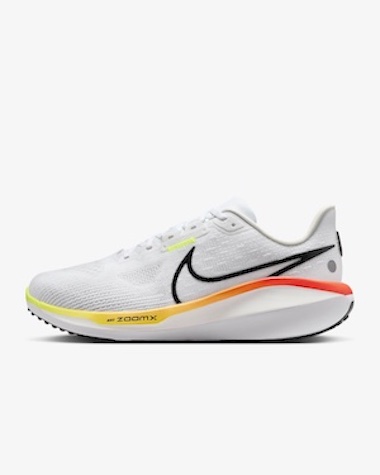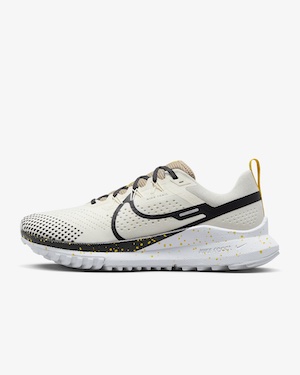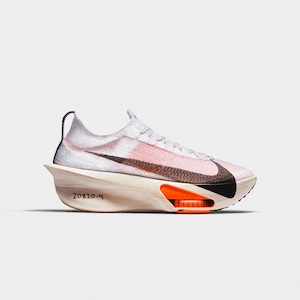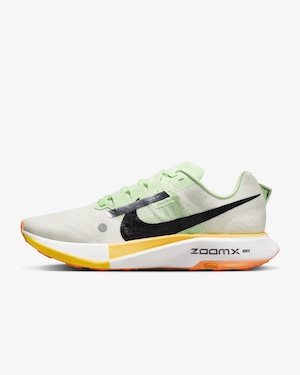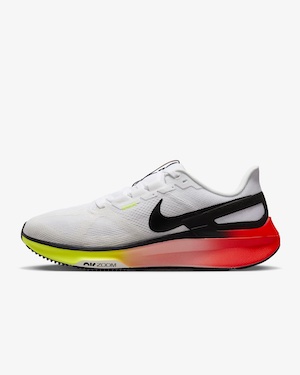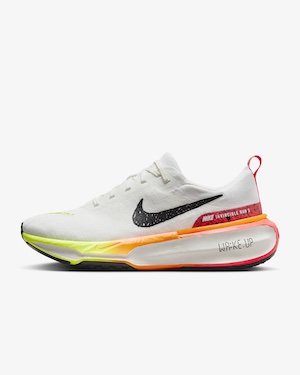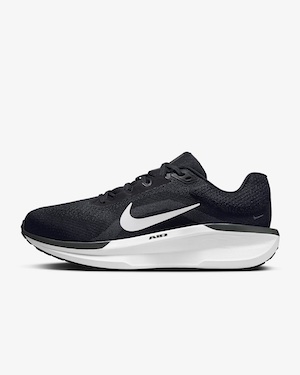
For this guide, we tested more than a dozen of the best Nike running shoes, including the Nike Pegasus 40. Photo: iRunFar/Eszter Horanyi
Most runners know Nike’s story and history. Founded by legendary University of Oregon track coach Bill Bowerman and one of his athletes, Phil Knight, the massive sports equipment and apparel company started solely as a running shoe company. The rest, as they say, is history. But with that history and the sheer number of shoes made by the company, finding the best shoe for your running needs can be challenging. No worries — we’ve got you covered.
The iRunFar team spent the past year testing Nike’s newest running shoes. Based on our findings, we created a list of shoes that should meet the needs of just about every type of runner. Looking for a road running shoe that you can also take on pavement, dirt, and gravel roads for everything from everyday training runs to long runs and light tempos? Check out the Nike Vomero 17, our best overall Nike road running shoe. Or take a look at our runner-up choice, the classic Nike Pegasus 40. Spend most of your time off-road? Check out the Nike Pegasus Trail 5. Need a stability shoe? We love the Nike Structure 25. Maximum cushion? Try the Nike Invincible 3. Below are our favorite Nike running shoes and what they excel at doing.
The Best Nike Running Shoes
- Best Overall Road Running Shoe: Nike Vomero 17
- Best Overall Road Running Shoe — Runner-Up: Nike Pegasus 40
- Best Overall Trail Running Shoe: Nike Pegasus Trail 5
- Best Overall Trail Running Shoe — Runner-Up: Nike Kiger 9
- Best Road Racing Shoe: Nike Alphafly 3
- Best Trail Racing Shoe: Nike Ultrafly
- Best Stability Running Shoe: Nike Structure 25
- Best Cushioned Running Shoe: Nike Invincible 3
- Best Budget Running Shoe: Nike Winflo 11
Best Overall Road Running Shoe: Nike Vomero 17 ($160)
Pros:
- Comfortable all-around shoe
- Maximum cushion for a soft ride
- Excellent responsiveness and energy return
Cons:
- Not the lightest
- A 10-millimeter stack height could be too much for some
There’s something to be said about a shoe that makes you smile the first time you run in it, and that’s what we experienced with the Nike Vomero 17. Why? It’s a soft, responsive, and fun running shoe. From top to bottom, Nike designed this shoe with comfort in mind. Let’s start with the bottom, which is an outsole made of high-abrasion rubber with small lugs. We took the Vomero off-road on primarily flat dirt and gravel trails and experienced minimal slippage, making us like it even more as an all-around shoe. Nike designed the outsole to have some flexibility, which we also felt boosted the shoe’s efficiency.
Nike packed the dual-density midsole with its ZoomX and Cushion 3.0 foams, creating a super soft and plush feel. Based on user feedback, Nike also removed the Zoom Air unit previously found at the shoe’s forefoot. Nike calls the ZoomX foam its lightest with the highest energy return, which helps boost the shoe’s spring and energy return. The insole is plush, the upper material is stretchy, and the tongue and heel collar are very soft.
To be frank, this shoe surprised us in a good way. We went into our testing fully expecting the Nike Pegasus to be our top overall road running shoe, but the Vomero beat it out based on its comfort, efficiency, response, and ability to handle multiple surfaces. The shoe excels on roads and pavement but more than holds its own on non-technical dirt trails and gravel roads.
Claimed Weight: 10.5 ounces (300 grams) | Drop: 10 millimeters | Support: Neutral
Shop the Men's Nike Vomero 17Shop the Women's Nike Vomero 17
Best Overall Road Running Shoe — Runner-Up: Nike Pegasus 40 ($130)
Pros:
- Excellent value
- Can handle multiple surfaces
Cons:
- Requires a bit of a break-in period
The Nike Pegasus 40 is one of the most classic and approachable road running shoes on the market. In its 40th edition, the Pegasus has stood the test of time. It remains one of the most versatile running shoes available and at an excellent value. After a break-in period, our tester found this shoe very comfortable. Nike made two updates to this model to help boost that comfort, including a redesigned midfoot and a new breathable engineered mesh upper.
Nike includes Zoom Air units at the forefoot and heel to boost spring in your stride. A plush sock liner and tongue add to the shoe’s overall comfort. Nike employs its classic waffle-inspired grippy outsole, which is flexible and holds traction on more than just pavement. Like the Vomero 17 reviewed above, we found the Pegasus 40 very capable of handling multiple surfaces. One tester had no problem taking it onto dirt, which included some unexpected springtime snow and mud. The Pegasus 40 and Vomero 17 are excellent, versatile road running shoes capable of off-road, dirt, or gravel running. The break-in period was the main reason this shoe didn’t come out on top, but it did make it into our best road running shoe guide.
If you primarily run on pavement, you can’t go wrong with either the Vomero or the Pegasus. Both are tried-and-tested models that are versatile and excel in multiple applications, making them excellent all-around running shoes.
Claimed Weight: 10.2 ounces (289 grams) | Drop: 10 millimeters | Support: Neutral
Shop the Men's Nike Pegasus 40Shop the Women's Nike Pegasus 40
Best Overall Trail Running Shoe: Nike Pegasus Trail 5 ($140)
Pros:
- Ideal for mixed-surface runs
- Dialed-in upper with a great insole
- Lighter than previous models
Cons:
- None yet
The Nike Pegasus Trail 5 isn’t just our favorite Nike trail running shoe — it’s one of our favorites in our best trail running shoes guide. Our primary tester for this shoe calls it her “magic slipper” for daily, non-technical trail running. At 10.2 ounces, they’re not the lightest shoe. And the 9.5-millimeter drop is on the higher end. But for anyone looking for a daily trail runner from Nike, the Pegasus Trail 5 is as good as it gets.
Let’s start with the upper. Nike used runner-informed data to redesign the previous version, including using breathable engineered mesh. This version keeps that construction with Nike’s Flywire technology, which helps boost midfoot security with an extra band. Our tester liked the improvements made to the ankle collar and Achilles notch area. The improved cushioning and heel cup fit helped our tester’s tender heel and Achilles area. We also like the loops added to the heels of the shoes. This is a small change but it gives the option to attach your shoes to a backpack or bag using a carabiner.
The shoe’s midsole features Nike’s ReactX foam — an upgrade from the React foam in the previous version. Nike claims the ReactX foam reduces the shoe’s carbon footprint by 43% and increases the efficiency by 13%. We’ll be honest, we have no idea how Nike calculates that, but we’ll take their word for it. On the ground, in practice, we did find the shoe more comfortable and efficient compared to the previous version, especially during longer runs of 10 to 20 miles and transitioning from dirt singletrack to gravel or paved roads.
Nike employs its proprietary All Terrain Compound (ATC) for the shoe’s outsole. It also widened the overall footprint of the shoe by a few millimeters and updated the lug pattern. Overall, this was again an improvement for us. The new ATC rubber is more pliable, making it flex better on trails. We also found it stickier than previous versions, improving the shoe’s ability to not slip on slabs or other rocks.
Versatility is the main theme between our top three Nike running shoes — the Pegasus Trail 5, Pegasus 40, and Vomero 17. Most runners don’t exclusively run on technical singletrack, paved roads, crushed gravel, or dirt. We run on all sorts of surfaces and trail types, and all three Nike shoes can excel on multiple surfaces. But if you’re primarily running on trails, the Pegasus 5 should be the pick.
Read our Nike Pegasus Trail 5 review.
Claimed Weight: 10.2 ounces (289 grams) | Drop: 9.5 millimeters | Support: Neutral
Shop the Men's Nike Pegasus Trail 5Shop the Women's Nike Pegasus Trail 5
Best Trail Running Shoe — Runner-Up: Nike Kiger 9 ($160)
Pros:
- Excellent traction
- Good comfort and support
- Solid durability
Cons:
- Relatively narrow toebox and platform
Like the Pegasus Trail, the Nike Kiger 9 is another solid all-around trail running shoe. Our tester enjoyed its excellent traction, durability, support, and comfort. Let’s start with the upper, which Nike updated for this model and built with engineered mesh. It’s light while still able to keep out debris. The lower part of the tongue is gusseted to reduce the dirt that makes it into the shoe. A midfoot band helps secure the foot from unwanted jostling inside the shoe. Our one complaint is that the upper didn’t dry particularly well after running in a rainstorm.
The shoe’s midsole also got updated for this iteration as Nike removed the forefoot Zoom Air unit and used the brand’s React foam. This created a lightweight and responsive ride, and our tester was pleasantly surprised with the shoe’s softness and comfort. They reported the shoe was so comfortable that they often wore it casually.
Lastly, the outsole provided a superior grip thanks to multidirectional lugs and high-abrasion rubber. Our tester had confidence moving quickly on uphills and downhills and even jumping from rock to rock. We named the Pegasus Trail our favorite Nike trail running shoe because of its overall performance and value, but the Kiger is right there with it. You won’t go wrong with either shoe.
Read our Nike Kiger 9 review.
Claimed Weight: 10.3 ounces (292 grams) | Drop: 4.5 millimeters | Support: Neutral
Shop the Men's Nike Kiger 9Shop the Women's Nike Kiger 9
Best Road Racing Shoe: Nike Alphafly 3 ($285)
Pros:
- Lightest iteration thus far
- Comfortable, fast, excellent energy return
Cons:
- It virtually sells out immediately
The Nike Alphafly 3 is Nike’s premium, most teched-out road racing shoe. In its third iteration, Nike says it’s the lightest and most-tested version. The first version of this shoe — the Alphafly NEXT% — made waves in 2019 when Eliud Kipchoge wore them while breaking the two-hour mark in an unsanctioned marathon. In 2023, wearing a prototype of the Alphafly 3, the late Kelvin Kiptum broke the world marathon record, running 2:00:35 at Chicago. Simply put, the Alphafly has played a role in the fastest marathons ever run.
What makes them so fast? A ton of proprietary technology. Let’s start with the base, where Nike employs a new lightweight Fast Shot outsole for grip and traction. Previous versions had more of a wave pattern on the outsole, whereas this one has mini-lugs. The outsole rubber is also now continuous, connecting the heel to the forefoot for the first time. This improves the heel-to-toe transition, regardless of pace. The previous version really only felt good at faster paces.
The Alphafly 3 still has dual Air Zoom units in the midsole and now has a wider full-length carbon plate for improved stability. The high-stack midsole is made of ZoomX foam, offering exceptional energy return. The new last design offers improved arch comfort, and a molded sock liner should provide a little more support with the new lower arch profile. A new lace design makes a softer fit on top of the foot.
Put this all together, and we found that this shoe provided a faster and more comfortable version of the Alphafly 2, which we named our top pick in our best marathon shoes guide.
Claimed Weight: 7.1 ounces (202 grams) | Drop: 8.5 millimeters | Support: Neutral
Shop the Men's Nike Alphafly 3Shop the Women's Nike Alphafly 3
Best Trail Racing Shoe: Nike Ultrafly ($260)
Pros:
- Comfortable and fast
- Crosses over well to roads
Cons:
- Expensive
The Nike Ultrafly is Nike’s first off-road super shoe. Nike was the first to introduce a carbon-plated super shoe in 2017 with the Vaporfly, and while it wasn’t the first to introduce an off-road super shoe when it did, it was unsurprisingly one of the best. The shoe has a premium low-profile Vibram Megagrip Litebase outsole, which we found has excellent grip on wet trails and rocks. For the midsole, Nike uses its ZoomX foam and carbon Flyplate. The soft foam and carbon plate provide a soft, responsive, and energy-efficient response.
The shoe’s upper fits and feels like a road running shoe in a good way. The Vaporweave mesh is lightweight, breathable, and comfortable. We also love that Nike continues to expand its toebox, increasingly allowing the toes to splay naturally during the stride. In terms of racing shoes, Nike nailed it with the Ultrafly. We’d place it up with other high-end trail racing shoes like the Hoka Tecton X 2 and the Saucony Endorphin Edge. We took this shoe on runs up and down technical trails in California’s Santa Monica Mountains and on more gradual paths elsewhere within California’s Coast Range. It handles a wide range of surfaces and trail types. Yes, the price is a lot, but it’s well worth the cost if speed is your priority and it’s within your budget.
Read our full Nike Ultrafly review.
Claimed Weight: 10.5 ounces (300 grams) | Drop: 8.5 millimeters | Support: Neutral
Shop the Men's Nike UltraflyShop the Women's Nike Ultrafly
Best Stability Running Shoe: Nike Structure 25 ($140)
Pros:
- Light and responsive
- Excellent fit
Cons:
- Fairly aggressive 10-millimeter drop
The Nike Structure 25 is one of the best stability running shoes we’ve recently tested, and we feature it in our best stability running shoes guide. As Nike’s most stable shoe, it has a higher level of new foam to boost support and stability. The midsole makes a wide platform, and the increased rocker helps guide the foot into a more neutral stride — the intent of stability running shoes. While there is a Zoom Air unit at the forefoot for responsive cushioning, overall, this shoe is less springy than others in this guide
Nike softened the material around the heel and ankle for improved comfort, and a single-layer mesh upper breathes well. Overall, these shoes are on the lighter side of the stability spectrum, so if you need extra-stable shoes or maximum support, you probably want to venture outside of Nike. We also really liked the grippy rubber outsole and small lugs found on this shoe, which is similar to the outsole found on the Vomero 17. We took this shoe on dirt and crushed gravel trails and roads more than pavement, and it performed very well.
Claimed Weight: 11.4 ounces (322 grams) | Drop: 10 millimeters | Support: Stability
Shop the Men's Nike Structure 25Shop the Women's Nike Structure 25
Best Cushioned Running Shoe: Nike Invincible 3 ($190)
Pros:
- Soft and responsive ZoomX midsole foam
- The wide toebox and extra-wide sizing options accommodate more runners
Cons:
- Expensive
The Nike Invincible 3 is the brand’s maximum-cushion running shoe, and our testers liked it enough to place it in our best cushioned running shoe guide. We were particularly impressed with the premium ZoomX midsole foam, noting that it was comfortable, responsive, very durable, and able to last many miles. One tester ran a road ultramarathon in these shoes and didn’t notice the foam packing out at all. The 40-millimeter stack height at the heel makes this a taller shoe than previous models, but Nike also widened the midsole platform to increase the shoe’s stability.
Overall, this was one of the softest and most responsive running shoes we’ve tested recently. Nike’s ZoomX midsole is their premium offering, which shows up in the shoe’s cost. The rocker provides a stable and supportive ride, and the responsiveness of the midsole makes this shoe super fun to run in. The Flyknit upper has strategically placed zones of increased breathability.
Claimed Weight: 10.9 ounces (310 grams) | Drop: 9 millimeters | Support: Stability
Shop the Men's Nike Invincible 3Shop the Women's Nike Invincible 3
Best Budget Running Shoe: Nike Winflo 11 ($105)
Pros:
- Made with sustainable materials
- Affordable
Cons:
- Heavy
- High 10-millimeter drop
While it’s slightly absurd that our best budget shoe still costs more than $100, this seems to be the lowest price point for a reasonable road shoe in 2024, and the Nike Winflo 11 packs in a lot for the price. If you’re new to running, on a tighter budget, or don’t want to spend much on running shoes, it’s a great option. Nike uses its Cushion 3.0 foam for the midsole to save on costs but adds a full-length Zoom Air unit to help boost the comfort and energy return found in this shoe.
The updated upper is breathable mesh, and the rubber waffle-inspired outsole makes this shoe adequate for gravel roads, dirt paths, and pavement. As part of this update, Nike increased the forefoot and heel width for improved stability. We also love that this shoe comes in extra-wide sizes and features sustainable materials.
Claimed Weight: 11.7 ounces (332 grams) | Drop: 10 millimeters | Support: Neutral
Shop the Men's Nike Winflo 11Shop the Women's Nike Winflo 11
Comparing the Best Nike Running Shoes
| SHOE | PRICE | WEIGHT | DROP | USE |
| Nike Vomero 17 | $160 | 10.5 ounces | 10 millimeters | Road |
| Nike Pegasus 40 | $130 | 10.2 ounces | 10 millimeters | Road |
| Nike Pegasus Trail 5 | $140 | 10.2 ounces | 9.5 millimeters | Trail |
| Nike Alphafly 3 | $285 | Road racing | ||
| Nike Ultrafly | $260 | 10.5 ounces | 8.5 millimeters | Trail racing |
| Nike Structure 25 | $140 | 11.4 ounces | 10 millimeters | Stability road |
| Nike Invincible 3 | $190 | 10.9 ounces | 9 millimeters | Cushion road |
| Nike Winflo 11 | $105 | 11.7 ounces | 10 millimeters | Road |
| Nike Kiger 9 | $160 | 10.2 ounces | 4.5 millimeters | Trail |

Some of our favorite Nike running shoes are versatile enough to handle multiple surfaces and types of workouts. Photo: iRunFar/Nathan Allen
Glossary of Running Shoe Terms
These days, the anatomy of a running shoe can be complicated. We try to avoid jargon in our buyer’s guides, but sometimes it’s inevitable, so we put together a glossary of frequently used terms when describing running shoes.
- Stack Height: The stack height of a shoe is the space between the bottom of the shoe (where it connects with the ground) and the bottom of your foot. It’s typically measured in millimeters and runs between 20 and 40 millimeters. Most shoes have a higher stack height at the heel than the forefoot, but some have equally high stack heights at both the heel and forefoot.
- Heel-to-Toe Drop (or just Drop): Drop is the difference in stack height between the heel and the toe of the shoe. As mentioned above, most running shoes have some drop, with the heel slightly higher than the toe. Zero-drop shoes place the heel and toe at an equal level. Most running shoes range in drop from zero to 12 millimeters. We recommend trying different drop levels to find the best for your feet and stride.
- Outsole: The outsole is the bottom of the shoe and is typically made of a rubber material.
- Lugs: Lugs are protrusions of material on the bottom of the outsole designed to provide extra traction. They typically appear on trail running shoes, but some road shoes, like the Vomero 17 and Structure 25 will contain small lugs for added traction. The typical lug found on trail shoes is between three and six inches deep
- Midsole: The shoe’s midsole is the material between the outsole and the sock liner. Midsoles are made of foam and create cushioning for your foot. Most running shoe companies make proprietary foams, and it’s the midsole that is what often changes a shoe’s price. Companies tend to create base-level foams, mid-level foams, and racing foams. The difference is that the racing foams will be lighter and provide higher energy return.
- Rock Plate: The rock plate is a protective material that typically sits on top of the outsole of trail running shoes. It is usually made of plastic and keeps rocks, roots, or other sharp objects from reaching your foot. Rock plates vary in length, from covering just the forefoot to running the entire length of the shoe.
- Carbon Plate: Similar to a rock plate, a carbon-fiber plate sits between the outsole and sock liner. While the rock plate’s purpose is protection, a carbon plate’s purpose is to improve performance by increasing energy return from each foot strike.
- Upper: The upper is the material covering the sides and top of your shoe. It connects to the midsole and wraps around your foot. It is frequently made of engineered mesh.
- Toebox: The toebox is exactly what it sounds like — the front of your shoe where your toes go. Shoes have toeboxes of different widths, from narrow to wide. Trying different toebox widths will help you narrow down your preference.
- Rocker: Like a ski or a snowboard, a rocker design is a slight lift at the front and back of the shoe. Shoe companies implement rocker technology to improve running efficiency and economy and help runners naturally spring forward using their toes.

Testing previous versions of the Alphafly in marathon prep. Photo: iRunFar/Alli Hartz
Nike’s Two Main Foams
Running shoe companies often use proprietary materials and jargon to describe different parts of a shoe’s anatomy. Nike uses two types of foam in its running shoes.
- Nike ZoomX: Nike’s premium foam cushioning typically used in its higher-end racing shoes like the Alphafly 3. Derived from aerospace foam, ZoomX is Nike’s lightest, softest, and most responsive foam. Nike claims it gives runners 85% energy return.
- Nike React: Nike’s React foam was launched in 2017 to help reduce injuries among athletes. Typically found in Nike’s golf, basketball, and running shoes, React foam features Thermoplastic elastomers (TPE) and Ethylene Vinyl Acetate (EVA) and is lightweight, soft, and durable.
Why You Should Trust Us
The testing team at iRunFar has decades of running experience. To create this guide, we brainstormed and researched the most popular Nike running shoes on the market. We also pulled from our experience with and knowledge of Nike running shoes to create a list of about a dozen Nike shoes to test. For testing, we put at least 100 miles on each pair of shoes, and most of our recommendations now have hundreds of miles on them. Our testers are based around the Western United States — in Colorado, California, and the Pacific Northwest — and run on pavement, trails, gravel roads, and dirt paths. We evaluated these Nike shoes for fit, comfort, responsiveness, and durability.

The bottom of the Alphfly 3 (left) has changed significantly from the original Alphafly (right), creating better grip and more surface area connecting with the ground. Photo: iRunFar/Nathan Allen
How to Choose: A Buyer’s Guide for Nike Running Shoes
Running Surface
When deciding on a pair of running shoes, a good starting point is to determine if you want trail running shoes, road running shoes, or a hybrid that can perform both on pavement and trail. A road shoe will work if you primarily run on roads, sidewalks, or paved trails. You’ll want a trail running shoe if you are primarily running on off-road surfaces, including technical mountain trails. The truth is most people run on multiple surfaces, which is one of the reasons why we picked the Nike Vomero 17 as the best overall Nike running shoe. It can handle pavement, dirt, and gravel roads with ease. We also love the Nike Pegasus Trail 5 for its low-profile outsole that allows it to handle trails well without being overly annoying on pavement. The main difference between trail and road shoes is that trail shoes will have deeper lugs on the outsole for traction on dirt and uneven surfaces. Some road shoes have small lugs and rubber outsoles that will be fine for non-technical off-road runs, like on flat dirt paths or gravel roads. Other road shoes do not have lugs or a rubber outsole, and those are best kept purely on pavement.
Intended Use
Once you decide on your most likely running surface, it’s time to consider the shoe’s intended use. Are you looking for an everyday trainer, a shoe for workouts, a shoe for racing, or something that can do a bit of all three? Some shoes are incredibly versatile and can be used in many scenarios, while others are very specific. The Nike Alphafly 3, for example, is solely a racing shoe. You could also use it for speed workouts, but its range is limited. The Nike Ultrafly, on the other hand, is built a bit differently and could serve as a trail workout shoe as well as a race shoe.
If you’re looking for a more generalist shoe that excels at long runs on pavement or light dirt, everyday training runs, and the occasional speed or up-tempo workout, the Nike Vomero 17 is a good choice. If you’re looking for a shoe for recovery runs, we recommend the maximum-cushioned Nike Invincible 3.

The Nike Vomero 17 was our favorite road running shoe overall, in part because of its versatility and ability to handle multiple surfaces and workouts. Photo: iRunFar/Nathan Allen
Cushion
Speaking of maximum cushion, you might’ve noticed most of the shoes we recommended have at least moderate cushioning. The Nike Pegasus 40 has a pretty middle-of-the-road level of cushioning, while the Nike Invincible 3 has maximum cushioning. It used to be that if you wanted a maximum-cushioning running shoe, you had to deal with weight and clunkiness. But those days are over. With technology like Nike’s Zoom Air units, React foam, and ZoomX foam, you can get maximum cushion shoes that remain lightweight and super responsive.
Like most things in a running shoe, the amount of cushion someone wants is a personal choice. Generally speaking, if you primarily run on harder surfaces, like pavement, we recommend erring on the side of more cushion. Extra layers of softness between your feet and the asphalt can cushion each foot strike and protect your bones and joints. We named the Nike Vomero 17 our favorite overall shoe for its high level of cushion created by the premium foam. It provides more cushion than the Pegasus 40 without sacrificing weight or efficiency.
Support
Most running shoes provide a neutral level of support, which is enough for most runners.
However, for some folks, a stability shoe might be necessary. The easiest way to determine if you need a stability shoe is to go to a running specialty store, hop on their treadmill, and have an employee watch your stride to see if you’re an overpronator. What’s overpronation? Let’s start with pronation, which is the natural inward collapse of the foot’s arch as it absorbs and distributes impact while running or walking. Everyone pronates. Underpronation — also called supination — is when the arch barely collapses and is generally associated with high arches. Those who supinate or have a normal range of pronation are good with neutral shoes. However, if you overpronate, meaning your arch collapses past the typical range, you might consider using stability running shoes. Generally, those with flat arches are more likely to need stability shoes. Again, it’s tough to tell on your own if you exceed the typical range of pronation, so having an employee at a running specialty store take a look isn’t a bad idea.
Stability shoes provide more support with a wider midfoot or overall platform, higher side walls, additional foam, or a rocker profile to help guide the foot into a more neutral gait. Nike doesn’t make many stability shoes, but the Nike Structure 25 is a solid option. The Nike Invincible 3 also has a bit of stability built in.
Fit
The best way to get a shoe that fits well is to go to a running specialty store and have them measure your feet. If this isn’t possible, there should be about a thumb’s width between the end of your big toe and the front of the shoe.
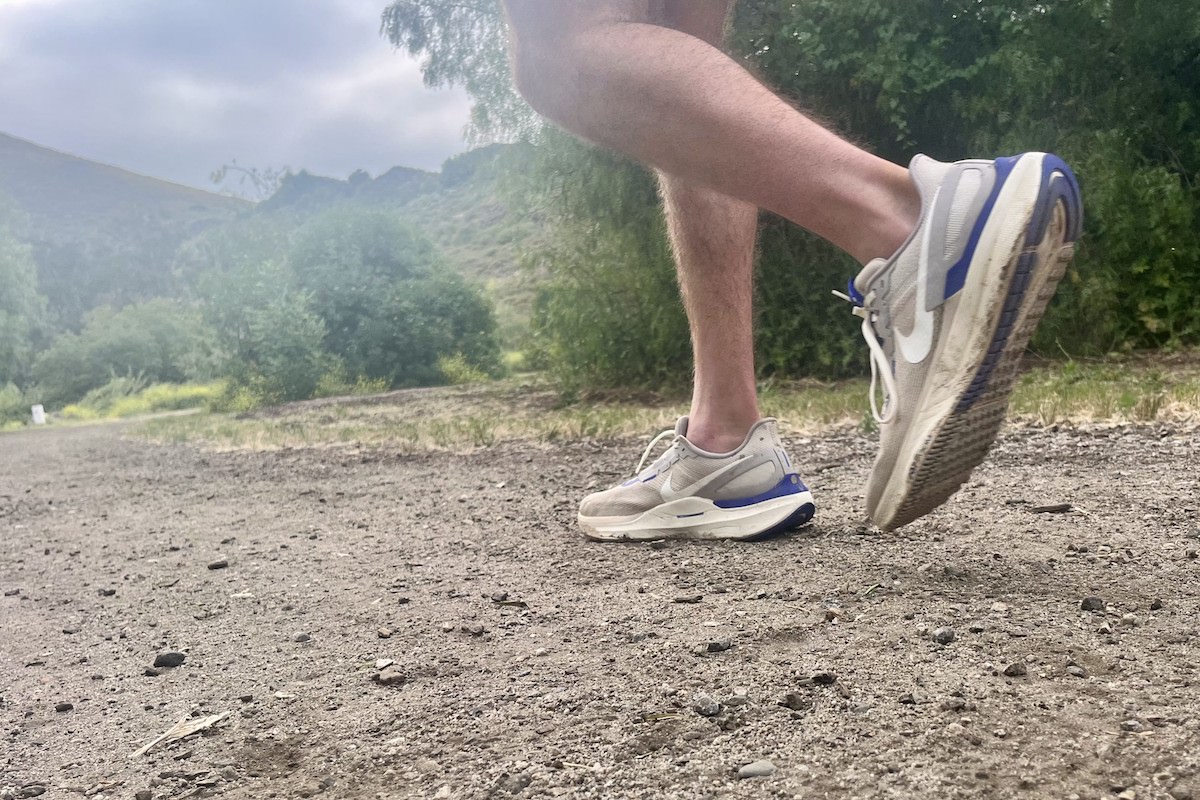
The Nike Structure 25 is one of our favorite stability shoes for its guidance and outsole, which is good for pavement, dirt, and crushed gravel. Photo: iRunFar/Nathan Allen
Frequently Asked Questions About Nike Running Shoes
What are the best Nike shoes for running?
The best Nike running shoes for you will depend on several factors, including the surfaces you like to run on and the distances you go. The Nike Vomero 17 is a very good running shoe — not just in the world of Nike but in the entire running shoe universe. We recommend them for anyone primarily running on roads, gravel or paved trails, or non-technical dirt trails. However, at $30 less, the Nike Pegasus 40 is a very tried-and-true road running shoe.
For trails, we recommend the Nike Pegasus Trail 5. Like its road sibling, it’s a very good generalist trail shoe that can handle quite a bit. If you’re looking for racing shoes, the Nike Ultrafly and Nike Alphafly 3 are the best for trails and roads, respectively.
Is Nike a good brand for running shoes?
It is. Many new running brands we love have emerged, like Hoka, Topo, On, Altra, and others, but Nike continues to innovate and change the game. Whether you love or hate the carbon-plated super-shoe movement, it’s here to stay — and Nike created it. And the brand still makes some of our favorite shoes, period. So, while there are plenty of other companies to pick from, Nike remains a very good option for many runners.
What is the top running shoe brand?
This depends on personal preference. While we don’t believe there’s one brand that will work for every runner, we do have a best trail running shoe brands guide.

An iRunFar team member testing the Nike Pegasus 40 running shoes in Colorado’s Rocky Mountains. Photo: iRunFar/Eszter Horanyi
Call for Comments
- Do you have any experience with the Nike running shoes in this guide?
- What is your most important element in a great pair of running shoes?
- Tell us about your favorite pair we might have missed so we can test them.
